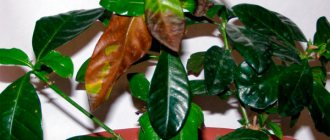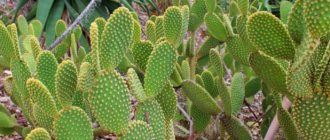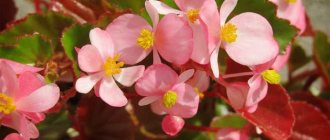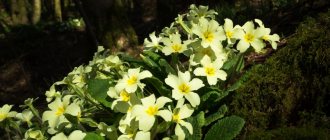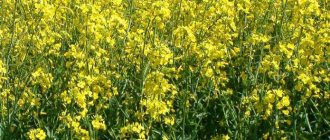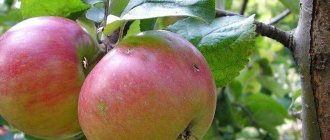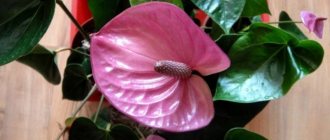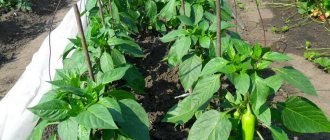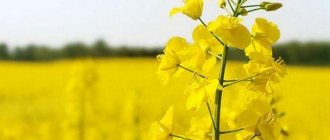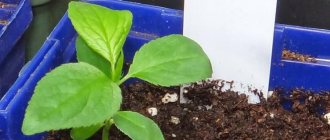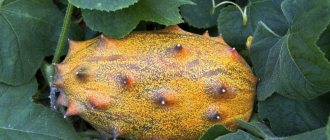Almost every garden has shady and damp places. When choosing perennials for landscaping such areas, preference should be given to those that can successfully grow with a lack of sunny color. One of these plants is Darmera thyroid.
Darmera thyroid or peltiphyllum is the only representative of the genus Darmera from the Saxifraga family. Its close relatives are heuchera and tiarella, which are widespread in our gardens. It comes from North America, where its habitat is the coastal zones of mountain rivers.
Darmera is a rhizomatous perennial. Its root system is very powerful and branched, but it is located shallow, just below the surface. Its leaves are collected in a basal rosette, have a rounded shape and thick petioles. The leaf blades are notched along the edges with pronounced veins, and their diameter can reach half a meter.
Darmera grows and develops best in shady and humid places. When grown in sunny areas, the leaves acquire an unsightly yellowish tint. This perennial is moisture-loving and during dry periods requires regular and plentiful watering.
Darmera is a winter-hardy perennial, but very often it dies from stagnation of moisture in the spring. In regions with harsh winters, additional mulching in the root area is required.
Care
In order for the peltiphyllum to delight you with its well-groomed appearance, you need to follow a number of simple rules:
For planting, it is best to choose shady areas; places with diffused lighting are also suitable.
The ideal option would be to plant next to large trees and shrubs that will create the necessary partial shade. In such places, the peltiphyllum is provided with a sufficient amount of sunlight and at the same time it is reliably protected from the scorching summer rays.
The soil for the plant should be loose and fertile with a neutral or slightly acidic reaction, but always without stagnant moisture. With excess water, the fleshy rhizomes of Darmera rot very quickly.
Watering should be intensive and frequent. With a lack of moisture, the plant forms small and clumsy ones.
In the spring, after the leaves grow, it is necessary to carry out preventive treatment of plants with fungicide solutions.
During the period of active growth, the plant must be fed with mineral fertilizers once a month. Darmera also responds well to organic feeding. Throughout the summer, leaf humus or compost can be added to the soil.
When a steady autumn cold snap occurs, the leaves must be cut off at a height of 30 cm, and the base of the bush should be well mulched with sawdust, peat or straw.
The undoubted advantages of peltifullum include the fact that it is practically not susceptible to disease and is not damaged by pests.
Diseases, pests and methods of combating them
Fungal diseases: fusarium, septoria, bacterial or heart rot affect the plant if preventive measures were not followed or it did not receive proper care. The main measures in the fight against such diseases are the timely destruction of diseased darmera or treatment of bushes with chemicals, a solution of potassium permanganate or formaldehyde.
Pests should be repelled by using environmentally friendly substances. Among folk remedies, these can be decoctions and tinctures with a pungent odor (ammonia, garlic, tomato tops).
And although Darmera thyroid is not particularly demanding in terms of care, the plant can nevertheless be damaged by various insects and diseases.
However, experienced gardeners assure that the degree of damage to Darmera is much lower than that of most garden plants. And if the flower is provided with really good conditions for growth, there will be no diseases.
However, cases cannot be ruled out when darmera is still exposed to diseases and the negative effects of pests. One of the most common ailments that occurs in Darmera thyroid is fusarium. This is a fungus that can infect a flower at any age. The death of the plant begins from the root, and then the stems are affected and the leaves fall off. To prevent such a disease, it is necessary to use potassium permanganate.
Darmera thyroid is often affected by fusarium
Another common fungal disease that can affect Darmera thyroid is septoria. The disease is quickly transmitted from one plant to another, so diseased flowers must be quickly removed from the flowerbed.
READ MORE: Console table 48 photos modern models of console tables for the hallway, white folding options from Ikea and manufacturers from China
It is possible that if the Darmer is not properly cared for, the thyroid will be affected by bacterial or heart-shaped rot. In the first case, wet areas with a very unpleasant odor will appear on the leaves of the plant. The problem area will become larger and larger until the disease begins to resolve. Bacteria can live in the soil for up to 3 years, so you need to properly treat the soil before planting. In addition, it is necessary to carefully monitor the quality of planting material.
When affected by heart rot, the shoots and leaves will be deformed and will begin to wither over time. The infection can remain in the soil for a long time. Therefore, you should not ignore preventive measures before planting new plants and rules for caring for old bushes.
Like most flowering plants, Darmera thyroid is susceptible to various diseases and pests, although not to the same extent as other flowers. With proper care, this plant practically does not get sick, but if mistakes were made in watering or preparing the soil, then the disease can come unnoticed and destroy not only one plant, but the entire flowerbed. The most common diseases that damage Darmera thyroid are:
Reproduction
Like all plants, darmera can reproduce vegetatively (by dividing overgrown rhizomes) and by seeds. The first method is the most preferable; when used, you can obtain adult plants of large sizes already in the 2nd year.
To propagate peltiphyllum vegetatively, in early spring (when the ground has just thawed) or late autumn, the rhizomes are carefully divided into sections according to the number of buds using a sharp knife.
Cuts on pieces of rhizomes must be sprinkled with charcoal powder. The resulting sections are planted in pre-prepared planting holes, at the bottom of which humus or compost is poured.
The depth of planting of rhizomes should be no more than 10 cm. If planting was successful, then after 2 weeks the first young leaf will appear above the surface of the ground.
Advice! In the first winter after transplantation, young plants need shelter.
With the seed propagation method, planting material needs preliminary preparation. 2-3 weeks before the expected planting date, the seeds must be kept at a temperature of about 5 degrees and high humidity. After such preparation, they are sown in containers with light and nutritious food.
Darmera seedlings develop very slowly; adult plants can only be seen in the 3rd or 4th year. Therefore, the seed propagation method is used very rarely; it is mainly used for selection purposes.
From seeds
The seeds are placed in a cool, dark place. Ideally, this should be a cold basement with high humidity. The room temperature should not be higher than 5 degrees. Under these conditions, the seeds are hardened within 30 days.
After this, the seeds should be planted in a container filled with light, loose, fertilized and moist soil.
The first shoots will appear in a few weeks. Young dwarfs may seem small and weak, but in fact they are already ready to be transplanted into open ground to a permanent location. Immediately before planting, they prepare the soil: weeds are pulled out of the ground, loosened and fertilized.
This method is considered difficult because it requires constant maintenance of a certain room temperature and high air humidity. The soil in which the seeds grow must also be moist. However, even if the instructions are strictly followed, the seedlings will turn into lush bushes only after a few years.
Use in landscaping
Darmera plants are valued for their large and beautiful leaves, as well as their showy flowers. This unpretentious perennial is used to create flower beds in shady areas, and it can also be planted in separate clumps under tall trees. It is very well suited for decorating the coastal zone of natural and artificial reservoirs.
The huge leaves of peltiphyllum are capable of covering large areas; this feature must be taken into account when planting flower beds. Darmera gets along well with most shade-tolerant perennials. Hostas, meadowsweet and anemones are perfect partners for her. It can also replace gunnera, which does not tolerate frosty winters very well.
There are also compact varieties of Darmera, for example, “Nanum”. The diameter of this plant does not exceed 45 cm. It can be successfully used for landscaping small areas and small ponds. In addition, the leaves of this variety have a very bright color, combining crimson and yellow tones.
While watching the video you will learn about growing saxifrage from seeds.
The use of perennials in landscaping is a promising and fashionable trend in landscape design. In addition, flower beds created from such plants can successfully grow and develop with minimal care for many years.
Noticed a mistake? Select it and press Ctrl+Enter
to let us know.
(Darmera) or peltiphyllum
thyroid (Peltiphyllum Peltatum) is a winter-hardy, unpretentious perennial for shady and semi-shady places of the Saxifraga family. Other representatives of this family (heuchera, spleenwort, saxifrage, etc.) have been living in our gardens for a long time, but darmera is a rarity.
Under natural conditions, peltiphyllum grows in some states of the USA. Darmera has unusually beautiful large round leaves, shield-shaped, rising above the ground on strong, strong petioles to a height of up to 1 m. The embossed leaves of peltiphyllum are very similar to the leaves of astilboides, but slightly smaller. In early spring in May, Darmera first produces fluffy flower stalks about 50 cm long with small, very delicate pale pink flowers, collected in corymbs with a diameter of about 10-12 cm. Only after flowering do majestic funnel-shaped leaves grow, whose autumn color is simply magnificent.
Darmera inflorescence
Location, soil
I recommend planting darmera in shady and semi-shady places. The best place is on the shore, since the plant is moisture-loving, but does not tolerate stagnant moisture. Unfortunately, it burns in the sun - the leaves turn pale and turn brown along the edges when there is not enough moisture.
Darmera can grow in any soil without any care for many years. However, it prefers loose, moisture-absorbing, fertile areas, where it grows faster. The optimal soil acidity value for darmera is pH 6-7. Before planting, you should prepare the soil once and it will be enough for the growth and development of dharmera for many years. Recommended composition: garden loamy soil, peat (can be replaced with purchased universal soil), humus (compost), sand in a ratio of 2:1:1:1. To this mixture you should add 80 g of any granular fertilizer and mix well.
Landing
In garden centers you can buy darmera after flowering, when magnificent leaves have already grown. Before planting, the container with the plant is soaked in a solution of any stimulant (humate, epin, etc.) or simply in water until air bubbles stop appearing on the surface of the water (for about 20-30 minutes). Then the plant is planted in the prepared place, watered, and the soil around the petioles with leaves.
Darmera rhizome
Care
Darmera does not require care, as it does not suffer from anything and is not affected by pests. And under its large leaves the weeds die on their own. If for some reason the darmera is planted in the sun, then regular watering is required.
No fertilizing is required; darmera grows remarkably well without it. But if you wish, you can sprinkle 30-40 g of any granular fertilizer once a year (preferably in early spring before flowering). If you feed the plant while the flower stalks are growing, the inflorescences will be more luxuriant.
Reproduction
Darmera has a thick, knotty rhizome up to 6-7 cm in diameter, which is located on the surface of the soil. From this powerful rhizome, absorbent roots grow deep into the ground.
Rhizome segments
. From experience I can say that darmera calmly tolerates propagation by rhizome segments throughout the gardening season. However, you don’t need to expect any special decorativeness this year, and next season it will already be a wonderful ornamental plant. Cutting a piece from a powerful rhizome is not so easy: you will have to use a shovel and a sharp, fairly large knife. It’s better, of course, to break it off, then the cuts will heal faster, but this requires strength.
Even from a small piece up to 3 cm, an excellent plant grows. The cuts should be sprinkled with crushed coal. A piece of rhizome is placed at the planting site on top of the prepared soil, watered and sprinkled with a layer of slightly damp soil up to 1 cm. After about 2-3 weeks, a leaf begins to appear - the darmera has taken root.
Seeds
. Darmera can be propagated by seeds, but in the conditions of the Moscow region, the plant has never set seeds in 7 years. When propagated by seeds, peltiphyllum will bloom only for 3-4 years.
Application in landscape design
For spring decorative purposes, it is recommended to plant spring bulbous plants between the thick rhizomes of darmera lying on the surface: , scylla, species and. Peltiphyllum looks great when planted alone - it is a magnificent exotic bush with beautiful leaves. Can be planted under trees, next to large shrubs (wooden grass,). In a shady garden, the following are suitable companions for darmera: ferns, podophila, Rogersia, meadowsweet.
We learned about Peltiphyllum thyroidum, or Darmera, relatively recently in our country. The overseas plant was immediately appreciated by landscape designers, since Darmera thyroid is unpretentious and tolerates winter frosts well. In addition, peltiphyllum is not only a flowering plant, but also an ornamental foliage plant. What is Darmera thyroid (photos of leaves and flowers are presented below in the article)? How to properly grow this unusual plant on your site?
Thyroid darmera in landscape design
Darmera peltata is used in landscape design to decorate the banks of ponds or streams. The plant goes well with other shade-loving flowers: hosta, meadowsweet, Rogers, mountain weed, spindle.
Darmera is planted near flowering trees. They also make long flower beds along the shady side of the house and the fence.
Shield darmera is not suitable for decorating small ponds; massive foliage will cover the surface of the water
Description
The unusual thing about peltiphyllum is that during spring and summer its appearance changes noticeably. The flower appears first: Darmera corytaea blooms quite early, around the end of April or beginning of May. Lush spherical inflorescences consisting of small pinkish flowers bloom on tall peduncles of a red-brown hue. Plants during this period reach a height of 50 cm to a meter. The leaves are practically invisible - they grow after Darmera thyroid begins to bloom.
The leaves of the plant are round, with large finger-like veins, and under favorable conditions they grow into tall, lush shrubs. The diameter of each leaf can reach from 50 to 90 cm. The exception is the miniature variety Nanum, whose leaves do not grow more than 45 cm.
The color of the “summer” peltiphyllum is rich green in shaded areas or pale green if the darmera grows in the open sun. In autumn, the leaves of the shrub change color, acquiring a red-crimson hue interspersed with yellow or orange. In this form, Darmera thyroid adorns the garden plot until the first frost.
general characteristics
Darmera thyroid or, as this flower is also called, peltiphyllum thyroid, is increasingly becoming famous among gardeners, thanks to its decorative leaves and spectacular tall peduncles, as well as the ability to change the color of the leaves at different times of the year.
- Darmera is a herbaceous perennial that belongs to the Saxifraga family. The homeland of this plant is considered to be the forests of America, from where many popular flowers and shrubs originated, which were subsequently cultivated and took a strong place in our gardens and flower beds.
- This plant is actively used in landscape design. In a single copy, the flower looks simply fabulous thanks to its huge leaves and delicate blooms.
- Darmera's leaf plates are very large, can reach a diameter of 70 cm to one meter. They have a round, funnel-shaped shape, with serrated edges along the entire perimeter. The name of the flower is translated from Greek as “leaf-shield”. Indeed, especially in autumn, huge sheets of warm colors look great against the background of other garden flowers.
- The root system is tap-shaped and knotty in shape, with a diameter of 4 cm to 6 cm. During active growth, it develops root shoots, with the help of which darmera can be propagated. It has dark greenish buds. Sometimes a part of the knotty rhizome comes to the surface from under the soil layer.
- The peduncles stretch high above the leaves (length reaches 70 cm) and have a bare stem of a dark brown hue, slightly pubescent with white fibers. The peculiarity is that the peduncle grows in early spring, in April, before the young leaves bloom.
- The flowers are small, at the top of the peduncles they gather in panicles resembling fluffy balls. The color scheme changes from bright pink to delicate pinkish-white tones. The diameter of the flower is about 12 cm. The plant does not bloom for long: 2 - 3 weeks, and sometimes the seeds ripen in June.
- In flower beds and gardens you can also find a low-growing species of peltiphyllum thyroid, whose height is only about 40 cm. You can also find a bush with white flowering.
Considering the changes in the color of the leaves, this feature of the plant should be skillfully used in landscape design. Darmera also looks very impressive against the backdrop of blue water if planted near an artificial pond.
How to choose a suitable place in the garden?
You should choose an area where Darmera thyroid will feel as comfortable as possible based on the natural habitat conditions of the shrub. This delicate flower comes from the west coast of the United States, namely from the mountainous regions of California and Oregon. Most often, peltiphyllum is found on the banks of clean reservoirs, rivers and lakes. For this reason, it is considered an ideal plant for decorating a pond in a garden plot.
If there is no open source of water on the site, the peltiphyllum will need regular, abundant watering. It is important that water does not stagnate, otherwise the root of the plant will quickly rot. Therefore, the place where the peltiphyllum will be planted must be well ventilated and provide sufficient drainage of irrigation water.
In addition to plenty of moisture, successful growth of the shrub depends on sunlight. Darmera thyroid can grow in the shade and in direct sunlight, but in the latter case, strong light causes the leaves and flowers to grow smaller.
Peltiphyllum needs a large amount of sunlight only in the spring, when inflorescences form, so a good neighborhood for darmera would be the proximity of broad-leaved shrubs or trees, the leaves of which will protect from the sun only in summer. In addition to shrubs and trees, peltiphyllum feels good in tandem with shade-loving perennial plants such as hosta, Rogersia, anemone and others.
Planting Darmera
Darmera can be propagated by two simple methods: by dividing the rhizome or by seeds. Before planting seed material in the ground, it will be necessary to carry out preliminary stratification, that is, keep it in a humid environment at a fairly cool temperature of +4...+6 o C for three or four weeks.
Vegetative (root) propagation is much simpler. Peltiphyllum has a taproot, which over several years grows and begins to produce additional viable roots. To propagate the darmera shrub, the plant should be dug up, the rhizome divided and kept in a solution of a fungicide for two hours. Next, the plant is planted in prepared fertilized soil. The advantage of this method is that a plant planted in autumn will bloom fully next spring.
Watering, fertilizing
Frequent and regular watering is an important condition for the normal growth of moisture-loving darmera. When watering, as already mentioned, it is important to prevent water from stagnating in order to avoid rot or mold.
Peltiphyllum needs to be fertilized regularly with organic and mineral fertilizers, from early spring to autumn. It is enough to water the plant with liquid mineral fertilizer at least once a month. If necessary, liquid organic matter can be added more often - once every two weeks. During active development and growth, from the day of germination to the beginning of flowering, darmera needs feeding with dry organic fertilizers. For these purposes, both purchased mixtures and natural fertilizers are suitable: dry chicken droppings, leaf humus, dried manure.
Wintering the plant, additional care
Darmera can overwinter well in the ground if it is protected from frost in a timely manner. To do this, cut off the above-ground part, mulch the root part with a layer of compost and carefully cover the plant with dry sawdust, straw or a layer of fallen leaves. At low temperatures, it is recommended to additionally cover the darmera with a layer of snow.
In the spring, after removing the covering layer, the peltiphyllum should be watered with any fungicide. There is no need to additionally treat darmera against pests or flora diseases.
Darmera thyroid (peltiphyllum)
- This is a perennial plant, which has recently become very popular among our population. It is grown in open ground for further use in various fields. In order to plant correctly, and then grow and provide the wonderful flower with the necessary care in your garden, you should become more familiar with the information about the darmera itself, as well as all the intricacies of its cultivation. You can find this valuable information below.
Useful properties of the plant
Darmera thyroid has positive properties as a medicinal culture. It contains gallic acid, which is an antioxidant. It is an edible plant that is common in folk medicine.
Leaf extract has cleansing properties and protects DNA molecules from oxidation. Gallic acid is an industrial component for the production of ink dyes and tanning products. In addition, when used correctly, Darmera has a preventive effect against oncology and viral diseases.
To summarize, we can say that Darmera thyroid is a very useful ornamental plant. It can decorate any garden and looks good in compositions near various bodies of water. In addition, the plant is quite easy to care for, which is reduced to high-quality watering.
What it looks like and where it grows wild
Belongs to the herbaceous family Saxifragaceae, grows wild with a powerful and knotty root system. The leaves of the plant are quite large and basal, located on thick petioles, have a rounded shape with notched edges (about 50 cm in diameter), and the peduncle is not only slightly larger in size (60 cm long), but also grows relatively earlier than the leaves themselves.
The flowers of peltiphyllum are the very part that gives it its main attractiveness and decorativeness; they are collected in corymbose 12-centimeter inflorescences and have a soft pink tint.
The homeland of the wild species is the mountainous regions of North America, where it is found along the shores of clean reservoirs.
Did you know?
The name "Peltiphyllum" comes from the Greek words pelte - shield and phyllon - leaf. They gave it to the flower, most likely, because it grows large foliage that somewhat resembles a shield.
What kind of plant is this?
We recommend that you read
Darmera thyroid is a plant that grows only in the United States of America, or more precisely, in the territory of two states: Oregon and California.
This plant was originally described by the American John Tory and the Englishman George Bentham. As a result, the species was named Saxifraga thyroid. Then, as scientific disputes were resolved, the same scientists identified this species as a separate genus and assigned it the name Peltiphyllum thyroid.
In parallel, another scientist, A. Kellogg, worked on the study of this plant. He gave the species the name Darmera peltata. So this plant is lucky - it has several names, and all of them are correct. However, this causes some confusion among practitioners who simply want to breed a plant with certain properties. However, for some reason the name Darmera is more popular, although the designation Peltiphyllum thyroid is not so rare.
This plant can be described as follows:
- 1The root system is taproot. After several years of growth, Darmera develops a massive rhizome that produces additional roots.
- 2 Leaves are simple, round, palmately lobed. The leaf blade is very large - almost 1 m in diameter. The leaf really resembles a battle shield. The petioles of such leaves are thin, but very strong and long, up to one and a half meters in length.
- 3Flowers are small, bisexual, five-membered. The petals of the flowers are almost white, with a slightly pinkish tint. However, the umbrella inflorescences appear pink due to the dark pink core of the flower.
A distinctive decorative feature of this plant is its early flowering. Pink inflorescences on tall stalks grow before their giant leaves appear. The flowering shoots of Darmera reach a height of up to one and a half meters.
Selecting a location
Despite the fact that darmera is not a capricious plant, in order to plant and properly grow it in your garden, you need to take into account a number of certain factors necessary for this. Let's start with preparation.
Lighting
The lighting at the planting site of the peltiphyllum should be well-dark, since its delicate moisture-loving leaves do not tolerate the sun at all; from bright rays, the wild plant completely loses its “presentable” appearance, the leaves noticeably fade, and the edges become dark brown from drying out. They grow in the shade for years and feel great.
The soil
But darmera is very indifferent to a variety of varieties; it can grow in completely different soils for many years without getting sick or suffering. However, the best option for a characteristic flower would be loose, fertile and moisture-containing places (6-7 pH), where it grows much faster and blooms more beautifully. Recommended and proven composition over the years:
- garden loamy soil;
- purified sand;
- 80 g of any .
All prepared ingredients, except fertilizer, should be mixed in a ratio of 2:1:1:1.
Planting and propagation
The processes of planting and propagation of peltiphyllum thyroidum occur in two ways - by seed and by dividing the rhizome; they differ greatly in the level of complexity, but, fortunately, in both cases, the expected shoots ultimately give a good result, and beautiful plant decorations appear in the garden.
Growing from seeds
If you decide to grow a wild, moisture-loving flower using its seeds, you will have a harder time, since the process itself lasts much longer than the vegetative method, does not always promise a 100% result, and the desired first flowering during generative propagation occurs only 2 years after planting.
Stages of seed germination:
- preliminary preparation of planting material (3-4 weeks before planting): place the plant seeds in a cool place with a temperature of +5°C, high humidity, keep there for one month;
- after preliminary (point above), plant in a selected container with light and nutritious soil;
- The first shoots will please you after quite a long time, but when this happens, the sprouts are transplanted into open, pre-fed soil.
Important!
An adult darmera bush can only be seen after 3-4 years. Therefore, it is practiced quite rarely, mainly used only for selection purposes.
Dividing the bush
Darmera is also propagated by dividing the bush (by rhizome segments). In the spring or autumn, the root is neatly divided into several parts with buds sleeping on them, which will eventually grow, creating an amazing plant on the site.
The detailed vegetative process should occur according to the following rules:
- Before planting, the cut off parts of the rhizome must be kept in a disinfectant solution for several hours. This will be an excellent prevention of fungal infections;
- prepare the soil and dig a hole of the desired size, at the bottom of which you should definitely put a layer, and on its surface - non-recyclable organic matter: leaves, grass;
- The hole must be covered from above with soil with the addition of sand and
Details
How and where to plant
Climatic conditions for comfortable development of Darmera
Darmera is not very common, in America it can only be seen in Oregon and California. It is considered a mountain plant and can grow well at an altitude of 2 thousand meters. To take root, it needs fertile and acidic soil.
It loves moist air and is often found in coastal areas near the ocean. Darmera is uncomfortable in the open sun, so it will grow with great pleasure in shaded areas, under tall bushes and trees. It can be as close as possible to other cultures, and at the same time fully develop.
Best place to land
Darmera is ideal for planting near an artificial pond. A particularly favorable place is one that is blown by the wind and is in the light, but not in the direct rays of the sun.
The soil should be sufficiently fertilized and loose. If the side is sunny, it is better to plant tall shrubs nearby; in the garden these could be fences or outbuildings. Young seedlings need more attention; an adult plant can survive in an area with periodic sunlight.
Ways to propagate and plant Darmera thyroid
Planting a perennial can be done by seed propagation and division.
Seed propagation is quite time-consuming and is considered more difficult. First, the seeds need to be prepared, for which they are sent into the cold for a month for stratification. After a while they are kept in dark conditions.
After preparation, planting occurs in several stages:
- filling the container with suitable soil with drainage;
- after the first shoots appear, the container is sent to a cool place with light lighting (this could be a window on the north side);
- abundant watering during the active development of seedlings;
- with the appearance of a true leaf, the sprouts are planted in containers with a diameter of 10 cm;
- after 1.5 weeks, the seedlings are fed with complex fertilizer for ornamental plants;
- in early autumn, seedlings can be planted in open ground on a previously prepared site;
Important! If you follow all the rules for growing Darmera from seeds, it will take about 3 years to take root and fully adapt.
Dividing a bush is the most accessible planting technology. To do this, you need to remove an adult plant from the soil and divide it into several parts so that a pair of buds remain on each.
All cuts are made with a sharp cutting tool and sprinkled with coal. In this state, Darmera thyroid must spend an hour in the fresh air to dry the rhizomes.
Before planting a plant, the soil must be prepared, for which organic fertilizers are applied. Dividing the bush allows the flower to adapt faster, which takes no more than a year, and flowering begins.
Rules for caring for flower crops
Peltifillium is a moisture-loving plant, so care involves sufficiently moistening the soil. This is especially important if there are no bodies of water nearby. Despite the love for moisture, excessive stagnation of liquid in the root area should be avoided; this requires a good drainage layer.
In addition to watering, you need:
- regular loosening of the soil;
- timely pruning of faded flower stalks;
- periodic thinning of foliage;
- regular feeding.
Attention! In addition to the fact that it is necessary to carry out all necessary actions related to care in a timely manner, it is important to monitor the general condition of the plant. Prevent diseases and ensure that there are no pests that can destroy the plant.
Rules for soil moisture
The qualitative development of Darmera and its appearance completely depend on proper watering. As already mentioned, you need to water abundantly, especially in the absence of reservoirs. If this is the case, the frequency of watering increases, especially in hot weather and in the absence of precipitation. You can understand that a Darmera flower will lack liquid by looking at the dry edges of the leaf blade. A way out of the situation could be to install a small container of water next to the bush; it will increase the ambient humidity.
The maximum amount of water is needed during the period of leaf growth, when flowering ends; watering can be reduced to a couple of times a week. Adult plants absorb water more actively and need watering a little more often than young seedlings.
Stagnation of water in the roots can lead to rotting processes. If there is groundwater nearby, in addition to drainage, you can organize an outflow for excess liquid.
Advice. Pentyphyllium loves shade and does not tolerate frost. In winter, it is recommended to cover the plant with dry leaves or humus.
How to fertilize Darmera?
The first application of nutrients should occur immediately after planting or when preparing the soil for this process. Until flowering begins, you can add dry mineral mixtures. When the active growth phase begins, organic matter in combination with minerals is suitable. This can be humus, manure, bird droppings. Once a month is enough for the plant to fully develop. In autumn, when preparations for winter begin, all feeding stops.
As Darmera gets older, its roots may come out, exposing the buds. To prevent them from freezing in the cold, the surface of the soil is well sprinkled with peat and horse manure. Such actions lead to the filling of nutrients even in cold times with the help of melt water.
How to prepare a plant for winter?
Darmera's winter hardiness is above average if wintering is properly organized. Before covering the soil surface with a mulch layer, the plant must be cut almost to the ground. Compost is used for covering, and dry leaves, wood shavings, and straw can be placed on top. In case of heavy snowfalls, you can make an additional shelter from snow.
With the arrival of spring, when the snow begins to melt, the protective layer is removed, and the perennial itself is treated with fungicidal agents. No further processing is required. Spraying against rot and fungus is only necessary in such circumstances.
Possible problems during cultivation
Among the fungal infections that Darmera thyroid suffers from, there are: heart-shaped and bacterial rot, fusarium, septoria, but this only happens in the absence of proper care for the plant. Among the radical measures to combat fungi is the destruction of the flower itself. You can try to cure it using specialized medications, as well as a solution of formaldehyde or potassium permanganate.
Natural remedies can be used to repel possible pests. You can use folk recipes, using tinctures with a strong garlic smell, ammonia, and tomato tops.
Darmera as a garden decoration
Darmera is a very ornamental plant. A mature bush has many large leaves that create a dome shape. Designers love to use this shrub to create artificial ponds next to small private lakes. The plant goes well with all flowering crops.
Darmera can decorate areas of borders if they are in the shade of tall bushes and trees. It can be planted on embankment areas, in parks next to fountains. It can grow not only in compositions, but also as an independent decoration.
The height of the plant is not small, so if planted next to artificial ponds, they should not be smaller, otherwise Darmera will look too large against their background.
Important! When planting a plant in gardens, you should take into account its future size. In 5 years, one bush will reach a volume of 1.5 meters and a height of about 100 cm, so initially the distance between plantings should be taken into account.

